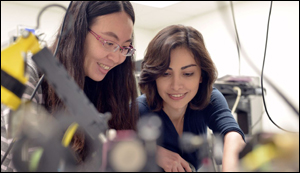Light-sensing system could show distant galaxies in unprecedented detail
10. 7. 2019 | UCLA | www.ucla.edu
Researchers at the UCLA Samueli School of Engineering have developed an ultra-sensitive light-detecting system that could enable astronomers to view galaxies, stars and planetary systems in superb detail.
The system works at room temperature — an improvement over similar technology that only works in temperatures nearing 270 degrees below zero Celsius, or minus 454 degrees Fahrenheit. The sensor system detects radiation in the terahertz band of the electromagnetic spectrum, which includes parts of the far-infrared and microwave frequencies. The system produces images in ultra-high clarity, and it can detect terahertz waves across a broad spectral range — an improvement of at least 10 times more than current technologies that only detect such waves in a narrow spectral range.

Its broad range capabilities could allow it to do observations that currently require several different instruments. It identifies what elements and molecules — for example, water, oxygen, carbon monoxide and other organic molecules, are present in those regions of space by seeing if their individual telltale spectral signatures are present.
Read more at UCLA
Image Credit: UCLA
-jk




